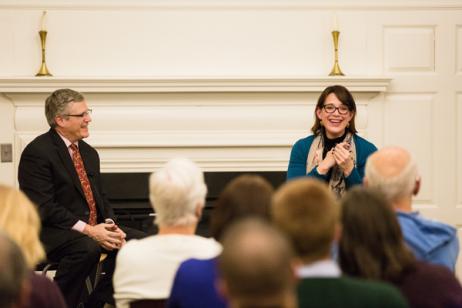What a pulpit to inherit.
The Riverside Church in New York City has been led by a succession of celebrity preachers and pastors over the decades: Harry Emerson Fosdick, James A. Forbes, Jr., and William Sloane Coffin Jr. ’56 B.D. It has also had a series of interim pastors in more recent years, speaking to the frayed state of affairs that awaited Amy Butler when she arrived in Morningside Heights 18 months ago to become Riverside’s first female senior minister.
 How Butler is successfully navigating the challenge, both by design and fortuitous naiveté, was the focus of her remarks before a large gathering in the Common Room January 29 when she met with the YDS community as part of the school’s new program in transformational leadership.
How Butler is successfully navigating the challenge, both by design and fortuitous naiveté, was the focus of her remarks before a large gathering in the Common Room January 29 when she met with the YDS community as part of the school’s new program in transformational leadership.
A Hawaii native, Butler had experience directing a shelter for homeless women in New Orleans and pastoring Calvary Baptist Church in Washington before arriving at Riverside. To say she experienced a change of scale would be an understatement. Her congregation in the capitol numbered around 250. Her staff at Riverside nearly matches that, with 150 working full-time and another 50 part-time.
“I thought being a pastor was about going to hospitals to visit sick people,” Butler told her YDS audience. “No, not now. It’s about dealing with HR issues and investments!”
The best advice she received upon arrival, she said, was to build a leadership team to help with the otherwise-impossible task of mastering all aspects of the huge operation. “You have to have someone to go in with you,” Butler said. “You cannot build an effective leadership system unless you have others’ eyes on other parts of the system.”
Butler started with small momentum-generating improvements—brighter lights, encouraging security guards to greet all who arrive with friendliness and warmth—and encouragement to congregants to break out of silos to become a more unified, cohesive church. When she arrived, Riverside had not one but nine separate prison ministries, all operating in isolation. “One Riverside” is the mantra she is implanting, and it’s now catching on, she said.
Butler has learned, too, the value of sometimes not knowing how things are conventionally done in a given environment. At Riverside, for example, senior ministers were not in the practice of inviting members to their homes. Butler didn’t know any better and started doing just that. The result: better relationships, more trust, and less anxiety about where Riverside is heading in its time of change.
Butler, whose YDS weekend intensive course was titled “Change or Die: Leadership during Transition,” used her public event to give the approximately 100 in attendance a tour through her blueprint for successful leadership, spiced with examples from her experience at Riverside. Among the steps she outlined:
- survey the landscape
- build your team
- build trust
- cast a vision
- implement cultural change, and
- create a culture of innovation
Running as a through line of sorts was her insight on the need for leaders to balance their own personality and way of doing things with the imperative to respect an organization’s history and values. For her, she confided, that has meant balancing her own personality—informal, funny, approachable—with the institution of the Riverside pulpit and the venerable men who preceded her as its occupants.